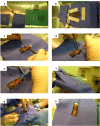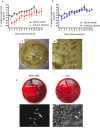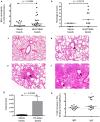A murine model of early Pseudomonas aeruginosa lung disease with transition to chronic infection
- PMID: 27804985
- PMCID: PMC5090221
- DOI: 10.1038/srep35838
A murine model of early Pseudomonas aeruginosa lung disease with transition to chronic infection
Abstract
Pseudomonas aeruginosa (PA) remains an important pathogen in patients with cystic fibrosis (CF) lung disease as well as non-CF bronchiectasis and chronic obstructive airways disease. Initial infections are cleared but chronic infection with mucoid strains ensues in the majority of CF patients and specific interventions to prevent this critical infection transition are lacking. The PA bead model has been widely used to study pulmonary P.aeruginosa infection but has limitations in animal husbandry and in accurately mimicking human disease. We have developed an adapted agar bead murine model using a clinical mucoid strain that demonstrates the key features of transition from transitory to chronic airways infection. Infected animals show very limited acute morbidity and mortality, but undergo infection-related weight loss and neutrophilic inflammation, development of anti-pseudomonal antibodies, variable bacterial clearance, endobronchial infection and microbial adaptation with PA small colony variants. We anticipate this model will allow research into the host and microbial factors governing this critical period in Pseudomonas aeruginosa pulmonary pathogenesis when transition to chronicity is occurring.
Figures



Similar articles
-
Pseudomonas aeruginosa microevolution during cystic fibrosis lung infection establishes clones with adapted virulence.Am J Respir Crit Care Med. 2009 Jul 15;180(2):138-45. doi: 10.1164/rccm.200812-1943OC. Epub 2009 May 7. Am J Respir Crit Care Med. 2009. PMID: 19423715
-
Assessing Pseudomonas aeruginosa virulence and the host response using murine models of acute and chronic lung infection.Methods Mol Biol. 2014;1149:757-71. doi: 10.1007/978-1-4939-0473-0_58. Methods Mol Biol. 2014. PMID: 24818948
-
Microbial pathogenesis in cystic fibrosis: pulmonary clearance of mucoid Pseudomonas aeruginosa and inflammation in a mouse model of repeated respiratory challenge.Infect Immun. 1998 Jan;66(1):280-8. doi: 10.1128/IAI.66.1.280-288.1998. Infect Immun. 1998. PMID: 9423869 Free PMC article.
-
Mouse models of chronic lung infection with Pseudomonas aeruginosa: models for the study of cystic fibrosis.Pediatr Pulmonol. 2000 Nov;30(5):413-24. doi: 10.1002/1099-0496(200011)30:5<413::aid-ppul8>3.0.co;2-9. Pediatr Pulmonol. 2000. PMID: 11064433 Review.
-
Challenges with current inhaled treatments for chronic Pseudomonas aeruginosa infection in patients with cystic fibrosis.Curr Med Res Opin. 2012 Jun;28(6):1059-67. doi: 10.1185/03007995.2012.674500. Epub 2012 May 10. Curr Med Res Opin. 2012. PMID: 22401602 Review.
Cited by
-
Outer Membrane Vesicles Displaying a Heterologous PcrV-HitA Fusion Antigen Promote Protection against Pulmonary Pseudomonas aeruginosa Infection.mSphere. 2021 Oct 27;6(5):e0069921. doi: 10.1128/mSphere.00699-21. Epub 2021 Oct 6. mSphere. 2021. PMID: 34612675 Free PMC article.
-
Pseudomonas aeruginosa Lipoxygenase LoxA Contributes to Lung Infection by Altering the Host Immune Lipid Signaling.Front Microbiol. 2019 Aug 14;10:1826. doi: 10.3389/fmicb.2019.01826. eCollection 2019. Front Microbiol. 2019. PMID: 31474948 Free PMC article.
-
Strain-specific interspecies interactions between co-isolated pairs of Staphylococcus aureus and Pseudomonas aeruginosa from patients with tracheobronchitis or bronchial colonization.Sci Rep. 2022 Mar 1;12(1):3374. doi: 10.1038/s41598-022-07018-5. Sci Rep. 2022. PMID: 35233050 Free PMC article.
-
Antibiofilm Peptides: Relevant Preclinical Animal Infection Models and Translational Potential.ACS Pharmacol Transl Sci. 2021 Jan 27;4(1):55-73. doi: 10.1021/acsptsci.0c00191. eCollection 2021 Feb 12. ACS Pharmacol Transl Sci. 2021. PMID: 33615161 Free PMC article. Review.
-
Biologically Relevant Murine Models of Chronic Pseudomonas aeruginosa Respiratory Infection.Pathogens. 2023 Aug 17;12(8):1053. doi: 10.3390/pathogens12081053. Pathogens. 2023. PMID: 37624013 Free PMC article.
References
-
- Martínez-García M. A., Soler-Cataluña J.-J., Perpiñá-Tordera M., Román-Sánchez P. & Soriano J. Factors Associated With Lung Function Decline in Adult Patients With Stable Non-Cystic Fibrosis Bronchiectasis. Chest 132, 1565–1572 (2007). - PubMed
-
- Murphy T. F. et al.. Pseudomonas aeruginosain Chronic Obstructive Pulmonary Disease. Am J Respir Crit Care Med 177, 853–860 (2008). - PubMed
-
- Martínez-Solano L., Macia M. D., Fajardo A., Oliver A. & Martinez J. L. Chronic Pseudomonas aeruginosa infection in chronic obstructive pulmonary disease. Clinical infectious diseases 47, 1526–1533 (2008). - PubMed
-
- Botha P. et al.. Pseudomonas aeruginosa Colonization of the Allograft After Lung Transplantation and the Risk of Bronchiolitis Obliterans Syndrome. Transplantation 15, 771–774 (2008). - PubMed
-
- Vos R., Vanaudenaerde B. M. & Geudens N. Pseudomonal airway colonisation: risk factor for bronchiolitis obliterans syndrome after lung transplantation? Eur Respir J 31, 1037–1045 (2008). - PubMed
Publication types
MeSH terms
Substances
Grants and funding
LinkOut - more resources
Full Text Sources
Other Literature Sources

